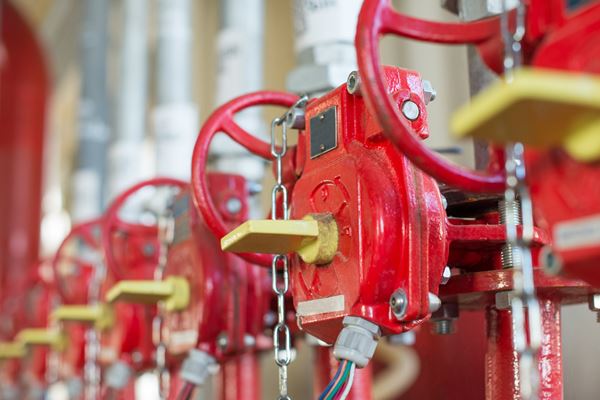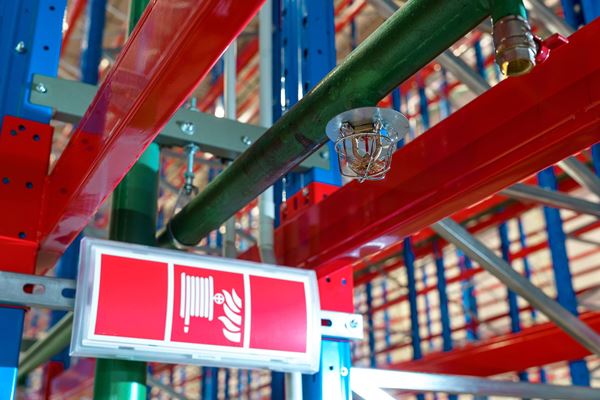Fire Protection Tips: Sprinkler Systems and Freeze Prevention

This vulnerability can result in significant failures and water damage. To prevent freeze failures, it is essential to understand the types of sprinkler systems, the mechanics of freeze events, and the best practices for maintenance, design, and installation.
Addressing these factors ensures the safety and functionality of fire sprinkler systems, especially in regions with freezing temperatures.
Types of Sprinkler Systems
Wet pipe sprinkler systems are designed for environments where temperatures remain above 40°F. In building areas where temperatures above 40°F cannot be assured, dry pipe, pre-action, and deluge sprinkler systems are used instead.
- Dry pipe systems keep the pipes filled with pressurized air or nitrogen, allowing water to enter only when a sprinkler head is activated.
- Pre-action systems offer an additional layer of protection by requiring a separate detection system to open the valve, making them ideal for high-value or sensitive areas.
- Deluge systems are employed in high-hazard areas and release water from all sprinkler heads simultaneously when activated.
Understanding Freeze Events in Sprinkler Systems
Freeze events in sprinkler systems occur when water in the pipes reaches freezing temperatures, i.e., 32°F or lower. Stagnant water in the pipes, especially at dead ends or poorly insulated areas, is particularly vulnerable to freezing.
As ice forms, it creates a blockage which expands as water continues to freeze. The expansion of the ice blockage compresses trapped water in the piping resulting in a significant increase in pressure. The increased pressure can result in a failure of the affected piping at the weakest component, often a cast fitting, coupling, or even a sprinkler. The actual failure often becomes apparent only after temperatures rise and the ice melts, allowing water to flow through the damaged section. This delayed manifestation complicates the identification and repair of the issue.
Preventing Freeze Failures in Sprinkler Systems
To prevent freeze failures, adhering to standards set by organizations like the National Fire Protection Association (NFPA) is crucial.
NFPA 13 outlines the installation requirements for sprinkler systems, emphasizing the need for systems other than wet pipe sprinkler systems or additional measures such as antifreeze solutions and heat tracing in areas where temperatures cannot be maintained above 40°F.
NFPA 25 focuses on the maintenance of these systems, requiring annual inspections to identify potential issues. These inspections are limited to what can be observed from the floor and do not require inspection of piping which is hidden behind walls. Moreover, these inspections are not intended to identify latent installation or design issues. As such, it is important for building owners to understand the limitations of installed sprinkler systems, the importance of proper insulation placement, and to maintain sufficient heating in their buildings.
Common Issues Associated With Freeze Failures
Common maintenance and installation issues that lead to freeze failures include improper insulation placement and inadequate heating in spaces where sprinkler pipes are located.
For example, in attics sprinkler pipes are often exposed to cold air without sufficient protection. Ensuring proper insulation and using techniques like tenting, where insulation is placed above the pipes to allow heat from rooms below to reach them, can mitigate the risk of freezing.
Additionally, dry sprinklers, designed to prevent water from entering the sprinkler barrel until needed, can be effective for some outdoor applications. Dry sprinklers can penetrate an exterior wall allowing the sprinkler to be fed from interior water-filled sprinkler piping but still provide protection for an outdoor space such as a deck or balcony. Care must be taken during installation to ensure that a sufficient length of the dry sprinkler barrel is within the heated indoor space to prevent freezing of the water-filled sprinkler piping connected to the dry sprinkler. As always, sufficient heat must still be provided to the interior space.
Fire Sprinkler System Freeze Prevention and Maintenance
Antifreeze Systems
Antifreeze systems also prevent freezing in fire sprinkler systems by using an antifreeze solution for sections of water-filled piping that cannot be maintained above 40°F. Due to safety concerns, the use of antifreeze systems has become less common.
High concentrations of antifreeze can be flammable, and there have been incidents where antifreeze solutions have worsened fires. Consequently, only pre-mixed solutions are now permitted to ensure safety.
Heat Tracing
Heat tracing can be used to maintain sections of water-filled piping above 40°F. However, heat tracing is often not cost effective as the heat tracing must be listed for use with sprinkler piping to be heated, must be supplied by electricity, and must be monitored to identify any failures of the heat tracing.
Failures in wet pipe sprinkler systems are usually due to an installation and/or design issue. In addition, a failure to maintain heat is often a cause of sprinkler system failures.
Investigating Fire Sprinkler System Failures
In the event of a fire sprinkler system failure, thorough investigation and documentation are necessary.
Collecting evidence, such as the condition of the piping and the specific sprinkler head involved, provides valuable insights into the cause of the failure.
Fire department incident reports and weather data can also offer important context, helping to determine whether freezing temperatures contributed to the issue. Maintenance history can also provide valuable insights.
This information is crucial for making informed decisions about repairs and future prevention measures.
Bottomline
Preventing freeze failures in fire protection systems necessitates a thorough understanding of sprinkler types, freeze mechanics, and adherence to maintenance and installation standards. Building owners and facility managers must ensure their systems are correctly designed, installed, and sufficient building heat is maintained to endure cold temperatures.
Maintenance is important for identifying issues associated with degradation of piping (i.e., corrosion) and ensuring that the water supply is connected. However, aside from maintaining interior heat, maintenance isn’t that important for preventing freeze failures - design and installation is.
Fire Protection Engineering Investigation | Envista Forensics
Envista's engineering professionals have years of experience in fire protection engineering and strong backgrounds in fire protection system inspection and analysis.
Need a Fire Protection Engineering Consultant?
Please contact us or visit our expert directory.
Our experts are ready to help.



